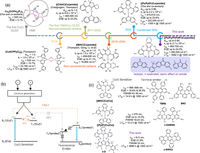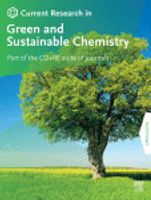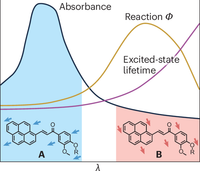Explore web search results related to this domain and discover relevant information.

Complexes 1–7 show blue to deep-red TADF emission (470–677 nm) in thin films with medium-to-high Φem of 0.39–0.90, short τem of below 1.2 µs, and large kr of 1.2–2.7 × 106 s−1. OLEDs based on these complexes as emitters exhibit EL λmax of 488–722 nm and EQEmax as high as 24.0%, with efficiency ...
Complexes 1–7 show blue to deep-red TADF emission (470–677 nm) in thin films with medium-to-high Φem of 0.39–0.90, short τem of below 1.2 µs, and large kr of 1.2–2.7 × 106 s−1. OLEDs based on these complexes as emitters exhibit EL λmax of 488–722 nm and EQEmax as high as 24.0%, with efficiency roll-off as small as 0.6% at 1000 cd m−2 and brightness up to 265,000 cd m−2.For example, when the concentration of emitter 6 increases from 2 wt% to 6 wt% and 10 wt%, EL λmax shifts from 690 (deep red region) to 720 nm and 722 nm (NIR region), while EQEmax decreases from 9.59% to 7.17% and 6.62% (Fig. 3c, d and Table 1). The red-shift in emission energy and decrease in efficiency may be due to the intermolecular interactions between these Cu(I) red emitters in the OLED emissive layer (EML), which can quench excitons at high doping concentrations.It was found that 2-D in RH exhibited higher Φem and lower knr than 2-H (Supplementary Table 5), which can be attributed to the use of deuterated carbazole ligands to reduce the vibrational frequency (Fig. 2e, f). This is why 2-D-based OLEDs have higher device efficiency.Although TADF OLEDs employing Cu(I) emitters 1–7 exhibit high efficiency and good operational stability, their EL spectra have large full-width-half-maximum (FWHM) values (> 100 nm for the yellow and red OLEDs; Table 1), showing unsatisfactory color purity.

Red Robin's Q2 Earnings: Operational Efficiency Gains vs. Traffic Headwinds Signal Strategic Crossroads
Red Robin Group (RRGB)'s Q2 2025 earnings report offers a compelling case study in the delicate balance between operational efficiency and customer traffic dynamics—a critical tension point for restaurant industry recovery and long-term investment potential.Red Robin's Q2 results demonstrate that operational discipline can offset external pressures. The 300 basis point labor efficiency gain—driven by refined scheduling and forecasting practices—was the primary driver of margin expansion. This achievement is particularly notable given rising ground beef and poultry costs, which are projected to add $2–3 million in expenses for the remainder of 2025.For long-term investors, Red Robin's Q2 results present a mixed but not discouraging picture. The company's operational efficiency gains are a testament to its management's ability to execute under pressure, but the traffic decline highlights the need for a more aggressive and innovative value proposition.In conclusion, Red Robin's Q2 earnings underscore the dual-edged nature of restaurant investing: operational efficiency can shield against external shocks, but without traffic growth, long-term value creation remains elusive.

Alizarin red (ARS) dye is a persistent and toxic pollutant in aquatic environments, posing a significant environmental threat. Among various treatment technologies, adsorption offers a practical and highly efficient method for dye removal. This study investigates the application of silica-supported ...
Alizarin red (ARS) dye is a persistent and toxic pollutant in aquatic environments, posing a significant environmental threat. Among various treatment technologies, adsorption offers a practical and highly efficient method for dye removal. This study investigates the application of silica-supported nanoscale zero-valent iron (nZVI) particles as adsorbents for the removal of ARS dye, with a focus on evaluating the adsorption kinetics and thermodynamic behavior of the process.Adsorption has drawn a lot of interest among the current treatment techniques because of its ease of use, economic feasibility, and high removal efficacy for a variety of dye pollutants6,7. Notably, its ability to eliminate colours at low concentrations makes it especially appropriate for environmental restoration and industrial wastewater control8,9,10. Adsorption’s versatility, which results from adjustable process parameters and a huge range of adsorbents, increases its allure for large-scale applications11. Alizarin Red dye is resistant to biodegradation and conventional wastewater treatment; therefore, it remains in water bodies12,13.The use of nanostructured materials in dye adsorption has shown a lot of promise in recent years19,20. Nanoparticles can interact with dye molecules like alizarin red more efficiently due to their high surface-to-volume ratios, variable surface chemistry, and availability of reactive sites21,22.Among nanomaterials for environmental cleanup, nanoscale zero-valent iron (nZVI) has garnered more attention due to its capacity to efficiently break down and immobilise dangerous substances36. In polluted matrices, its large specific surface area improves reaction kinetics, and its nanoscale size permits increased mobility and dispersion. The viability of nZVI for field-scale applications has increased due to recent developments in synthesis processes that have further reduced production costs.
Here we demonstrate highly efficient red/NIR RTP with boosted quantum yields (Φps) of up to 32.96 % through doping the thionated derivatives of phthalimide (PAI) (MTPAI and DTPAI) into PAI crystals. The red-shifted photoluminescence (PL) stems from a combination of the external heavy atom ...
Organic red/near-infrared (NIR) room temperature phosphorescence (RTP) materials with low toxicity and facile synthesis are highly sought after, particularly for applications in biotechnology and encryption. However, achieving efficient red/NIR RTP emitters has been challenging due to the weak spin- …Organic red/near-infrared (NIR) room temperature phosphorescence (RTP) materials with low toxicity and facile synthesis are highly sought after, particularly for applications in biotechnology and encryption. However, achieving efficient red/NIR RTP emitters has been challenging due to the weak spin-orbit coupling of organics and the rapid nonradiative decay imposed by the energy gap law.Here we demonstrate highly efficient red/NIR RTP with boosted quantum yields (Φps) of up to 32.96 % through doping the thionated derivatives of phthalimide (PAI) (MTPAI and DTPAI) into PAI crystals. The red-shifted photoluminescence (PL) stems from a combination of the external heavy atom effect and the formation of emissive clusters centered around electron-rich sulfur atoms.Keywords: doped crystals; emissive clusters; energy gap law; red/NIR luminescence; room temperature phosphorescence.

The team’s newly-imagined red LEDs are nearly three orders of magnitude smaller in surface area than previously reported devices, while exhibiting an external quantum efficiency of ~1.2%, matching many conventional micro-LEDs of any color.
With virtual reality putting displays within inches of the user’s eyes, researchers have been exploring how to make extremely small pixels. Nanowire LEDs are approximately 10,000 times smaller than standard phone display pixels, but until now, the red micro LEDs haven’t been efficient enough to be practical.These highly efficient, bright, and robust micro LEDs offer a promising future for not only crystal clear VR headsets, but for future on-chip integration with blue and green LEDs. “As traditional red-emitting LEDs become smaller and smaller, their efficiency keeps dropping,” said Dr.There are several reasons for this, including damage caused in the fabrication process of current red LEDs, as well as performance limits inherent in materials typically used. To overcome these weaknesses, the team, led by Prof. Zetian Mi, introduced specially-designed nanowires (with a width of about 1μm) to overcome fabrication-related problems, and introduced a material cocktail of indium gallium nitride to enable miniaturization of the devices, while preserving high efficiency.The team’s newly-imagined red LEDs are nearly three orders of magnitude smaller in surface area than previously reported devices, while exhibiting an external quantum efficiency of ~1.2%, matching many conventional micro-LEDs of any color.

Businesses must develop and demonstrate new micro-LED architectures that will lead to red micro-LEDs with high external quantum efficiency (>2%) when the pixel size is less than 5 microns.
Despite the reduction in LED chip size to below 10 microns, GaN-based blue and green micro-LEDs retain high performance in terms of external quantum efficiency. Most red micro-LEDs suffer from significant size-dependent efficiency droop due to serious surface recombination at the edges of the device.Businesses must develop and demonstrate new micro-LED architectures that will lead to red micro-LEDs with high external quantum efficiency (>2%) when the pixel size is less than 5 microns.Scientific literature proposes many approaches, such as those based on InGaN-quantum wells and quantum dots enhanced structures, to address this problem with some success. However, many of these approaches are for chips with larger dimensions than what is required in this solicitation. Despite this, they indicate there are potential paths towards realizing high-efficient, red micro-LEDs.“Laser Lift-off Mechanism and Optical-electric Characteristics of Red Micro-LED Devices,” Opt. Express, 31, pp. 7887-7899 (2023). “An Ultrahigh Efficiency Excitonic Micro-LED,” Nano Lett.

Red Hat, acquired by IBM in 2019, will integrate its back-office functions like HR, finance, and legal into IBM starting 2026 to boost efficiency and synergies. While core teams remain independent, concerns arise over cultural erosion and talent attrition. This move could enhance IBM's hybrid ...
Red Hat, acquired by IBM in 2019, will integrate its back-office functions like HR, finance, and legal into IBM starting 2026 to boost efficiency and synergies. While core teams remain independent, concerns arise over cultural erosion and talent attrition. This move could enhance IBM's hybrid cloud dominance despite autonomy risks.In a significant shift within the enterprise software sector, Red Hat, the open-source giant acquired by IBM in 2019, is set to transfer its back-office functions to its parent company starting in 2026. This move involves key departments such as human resources, finance, legal, and accounting, which will integrate into IBM’s operations. The decision, communicated to employees earlier this month, underscores IBM’s ongoing efforts to streamline operations post-acquisition, potentially enhancing efficiency but raising questions about cultural preservation at Red Hat.Ultimately, success will hinge on IBM’s ability to preserve Red Hat’s innovative core while harvesting efficiencies.Red Hat to Merge Back-Office with IBM in 2026 for Efficiency Gains
Thanks to a linear geometry and ... coinage metal(I) complexes. The resulting OLEDs delivered high external quantum efficiencies of 21.1% at a maximum and 20.1% at 1000 nits, together with a red emission peak at ∼630 nm....
The Cu(I) complex achieved satisfactory red emission, a high photoluminescence quantum yield of up to 70%, and a sub-microsecond lifetime. Thanks to a linear geometry and the acceptor and donor ligands in a coplanar conformation, the complex exhibited a high horizontal dipole ratio of 77% in the host matrix, first demonstrated for coinage metal(I) complexes. The resulting OLEDs delivered high external quantum efficiencies of 21.1% at a maximum and 20.1% at 1000 nits, together with a red emission peak at ∼630 nm.Rui Tang, Shuo Xu, Gang Cheng, Kam-Hung Low, Dongdong Zhang, Lian Duan, Chi-Ming Che. Highly stable and efficient copper(I) sensitizer for narrowband red organic light-emitting diodes with an operational lifetime (LT95) of up to 3689 h at 1000 cd m−2.Li-Ping Bai, Shu-Jia Zheng, Rui Xue, Deng-Feng Li, Ke-Die Li, Si-Qi Yu, Yuan Liu, Tian-Yi Li. Two-Coordinate Coinage Metal Complexes Featuring Imidazolium Carbenes: Realization of Efficient Blue Thermally Activated Delayed Fluorescence (TADF) for Organic-Light-Emitting Diodes (OLEDs).Jian-Gong Yang, Xiu-Fang Song, Gang Cheng, Siping Wu, Xingyu Feng, Ganglong Cui, Wai-Pong To, Xiaoyong Chang, Yong Chen, Chi-Ming Che, Chuluo Yang, Kai Li. Conformational Engineering of Two-Coordinate Gold(I) Complexes: Regulation of Excited-State Dynamics for Efficient Delayed Fluorescence.

Perovskites are promising environmentally sustainable materials for circularly polarized electroluminescence (CPEL). While another chiral nonemissive layer is required for the developed perovskite-based CPEL, we report herein a highly efficient circularly polarized electroluminescence based ...
Jingwen Yao, Yuling Huang, Haifeng Sun, Zhiyu Wang, Jie Xue, Zhifeng Huang, Shou‐Cheng Dong, Xihan Chen, Haipeng Lu. Efficient Spin‐Light‐Emitting Diodes With Tunable Red to Near‐Infrared Emission at Room Temperature.Efficient Red-Emissive Circularly Polarized Electroluminescence Enabled by Quasi-2D Perovskite with Chiral Spacer CationPerovskites are promising environmentally sustainable materials for circularly polarized electroluminescence (CPEL). While another chiral nonemissive layer is required for the developed perovskite-based CPEL, we report herein a highly efficient circularly polarized electroluminescence based on a single layer of quasi-2D perovskite with achiral phenethylammonium iodide (PEAI) and chiral S/R-1-(1-naphthyl)ethylammonium iodide (S/R-NEAI) as dual spacer cations.The as-fabricated film exhibits not only a circular dichroism (CD) signal but also prominent circularly polarized luminescence (CPL) activity with a maximum photoluminescence dissymmetry factor (glum) of ∼2.1 × 10–3. More importantly, a highly efficient, spin-polarized light-emitting diode (LED) was fabricated based on the in situ passivated quasi-2D perovskite with a peak external quantum efficiency of 3.7% and a maximum electroluminescence dissymmetry factor (gEL) of ∼4.0 × 10–3.ACS Publications

The rovyvon aurora a8x can run a white light around 5 times as long as a red light, same brightness, exact same battery. It seems to be the case for…
The rovyvon aurora a8x can run a white light around 5 times as long as a red light, same brightness, exact same battery. It seems to be the case for other lights as well. Is this only for side lights? Is it for all lights? I would think white would be a less efficient color, as it contains all the colors in it.So it takes more photons to create a lumen of red or blue. However some LED technologies are much more mature than others. Blue LEDs have had an insane amount of money poured into their development because of their use in white LEDs. The other colors haven't. So blue is just better at turning electricity into light. This usually called "conversion efficiency" or "quantum efficiency" or "radiometric efficiency."Lumen is not a unit for energy emitted, it scales with a Luminous efficiency function which represents humans sensitivity to photon wavelength. The actual energy efficiency should be measured in the product of photon flux and single photon energy. It's easier to produce high efficiency red Led than blue ones iirc.I am guessing it has to do with the semiconductor alloys and how efficiently they produce light. The red lights use a different material to make the light than the green ones do.


Discover the Red Push Button, a vital control component designed to enhance safety and efficiency in various applications. Learn more today!
Red Push Button, as a control component with both functionality and safety, has become an indispensable key part in the operation of equipment in various industries due to its unique design and reliable performance. Whether it is for emergency braking or precise control, it safeguards operational safety and process efficiency with stable performance.Red Push Button focuses on safety and empowers efficiency with technology. It is not only a "guardian" in emergency moments but also a "good helper" for intelligent management.Choosing it means adding a reliable guarantee for equipment safety and production efficiency.The core function of this red button lies in emergency stop operations. Its eye-catching red appearance complies with international safety standards, which can quickly attract the attention of operators in complex environments and shorten the emergency response time.
In terms of efficiency, GPT-5 completed Pokemon Red with only 33% of the steps (67 % less steps).
In terms of efficiency, GPT-5 completed Pokemon Red with only 33% of the steps (67 % less steps).Next up: GPT-5 vs. Pokémon Crystal (16 Badges + Red). The run starts soon on Twitch.


This study is the first application of a combined sonication and enzyme extraction technique as green technology to recover biological compounds from …
The peel of dragon fruit had sonication pretreatment for 10–30 min (X1), followed by hydrolysis using 0.1 % Pectinex Ultra SP-L enzyme at temperatures ranging from 30 to 60 °C (X2) for a duration of 60–120 min (X3). The Box-Behnken design was employed to structure the experiment. The levels of polyphenol, betacyanin, and antioxidant activity in the extract were utilized to assess the efficacy of the extraction method.The research demonstrated a substantial enhancement in efficiency by the application of ultrasound pretreatment during the enzymatic hydrolysis of dragon fruit peel.Dual green techniques used for the first time to extract antioxidants from red dragon fruit peel.

For generations, chemists have ... Barner-Kowollik and Georg Gescheidt discovered that photopolymerizations occurred with much greater efficiency when irradiated at the red edge of the photoinitiator absorption spectrum....
For generations, chemists have been taught that photochemical reactions will be most efficient when irradiated at the absorption maximum of the chromophore. But in 2017, a team led by Christopher Barner-Kowollik and Georg Gescheidt discovered that photopolymerizations occurred with much greater efficiency when irradiated at the red edge of the photoinitiator absorption spectrum.A puzzling mismatch between a molecule's light absorptivity and its photochemical reactivity can now be explained by considering the microenvironment around the absorbing molecules and the effect this has on quantum yield, which becomes wavelength dependent.Nature Reviews Chemistry - A puzzling mismatch between a molecule's light absorptivity and its photochemical reactivity can now be explained by considering the microenvironment around the...
Most “red-zone efficiency” stats only focus on teams’ ability to score touchdowns when they get inside the opponents’ 20-yard line or stop opponents when they cross the 20. It’s not great if a team reaches the red zone and fails to score a touchdown — but it’s even worse if the ...
Most “red-zone efficiency” stats only focus on teams’ ability to score touchdowns when they get inside the opponents’ 20-yard line or stop opponents when they cross the 20. It’s not great if a team reaches the red zone and fails to score a touchdown — but it’s even worse if the offense doesn’t score at all.Red Zone Plus/Minus accounts for touchdowns, field goals and stops inside the 20 on both offense and defense.If a defense allows its opponent into the red zone, it would be nice to make them settle for a field goal — even better if they can force a turnover or get a few sacks and keep the opponent off the scoreboard altogether.Here’s how we’ll build these rankings: Each week we’ll look at each team’s total red-zone trips for both offense and defense. Red-zone drives resulting in a touchdown earn six points. Field goals earn three points. If a defense allows a red-zone touchdown, that’s minus-six, and a red-zone field goal allowed is minus-three.


A Fifth Circuit panel struggled Thursday with when and how entities are allowed to object to Energy Department rules as seven conservative states presented their challenge to conservation standards for stoves and ovens.
“If states and industry and efficiency folks all come together and everybody agrees, then you can have a direct final rule,” said Joseph Scott St.
In addition, the addition of ... and reduces the nonradiative recombination. Consequently, a pure-red PeLED with an impressive efficiency of up to 24.2% has been achieved, which represents the highest reported value so far....
To achieve the desirable pure-red PeLEDs, several approaches have been developed to precisely tune the emission wavelengths. One widely used strategy is using mixed iodide-bromide perovskites, which has gained considerable development in recent years, with the external quantum efficiency (EQE) reaching 23.5% (7).Another strategy of color tuning for red emission relies on quantum confinement effects in low-dimensional pure iodide–based perovskites, especially quasi–two-dimensional (quasi-2D) perovskites, which could improve the device stability due to that the large-sized L site is hardly moved (11–14). Furthermore, quasi-2D perovskites with self-assembled multiple-quantum-well (MQW) structures have higher exciton binding energy and more efficient radiative recombination; these distinctive properties make quasi-2D perovskites ideal candidates for the emission layer in PeLEDs.In addition, the addition of small-sized cesium salts facilitates the formation of a continuous and hydrophilic charge transport layer, which favors the growth of the perovskite layer and reduces the nonradiative recombination. Consequently, a pure-red PeLED with an impressive efficiency of up to 24.2% has been achieved, which represents the highest reported value so far.J. Zhang, B. Cai, X. Zhou, F. Yuan, C. Yin, H. Wang, H. Chen, X. Ji, X. Liang, C. Shen, Y. Wang, Z. Ma, J. Qing, Z. Shi, Z. Hu, L. Hou, H. Zeng, S. Bai, F. Gao, Ligand-induced cation-π interactions enable high-efficiency, bright and spectrally stable rec. 2020 pure-red perovskite light-emitting diodes.

It continues to show that GPT-5 is an efficiency machine! ... GPT-5 Plays Pokémon Crystal - Last Update Annnnnnd it’s done! GPT-5 beat RED, the final boss, in 9,517 steps vs. 27,040 for o3 - a huge improvement. It went in under-leveled, but the strategy was strong enough to take RED down easily.
The Pokémon benchmark has a new efficiency champion: GPT-5 finished Red with only about 1/3 of the moves. A huge step forward.


Download the A red button on a laptop keyboard that says efficiency 67021618 royalty-free Stock Photo from Vecteezy for your project and explore over a million other images and backgrounds.

Most “red-zone efficiency” stats only focus on teams’ ability to score touchdowns when they get inside the opponents’ 20-yard line or stop opponents when they cross the 20. It’s not great if a team reaches the red zone and fails to score a touchdown — but it’s even worse if the ...
Most “red-zone efficiency” stats only focus on teams’ ability to score touchdowns when they get inside the opponents’ 20-yard line or stop opponents when they cross the 20. It’s not great if a team reaches the red zone and fails to score a touchdown — but it’s even worse if the offense doesn’t score at all.Red Zone Plus/Minus accounts for touchdowns, field goals and stops inside the 20 on both offense and defense.If a defense allows its opponent into the red zone, it would be nice to make them settle for a field goal — even better if they can force a turnover or get a few sacks and keep the opponent off the scoreboard altogether.Here’s how we’ll build these rankings: Each week we’ll look at each team’s total red-zone trips for both offense and defense. Red-zone drives resulting in a touchdown earn six points. Field goals earn three points. If a defense allows a red-zone touchdown, that’s minus-six, and a red-zone field goal allowed is minus-three.






